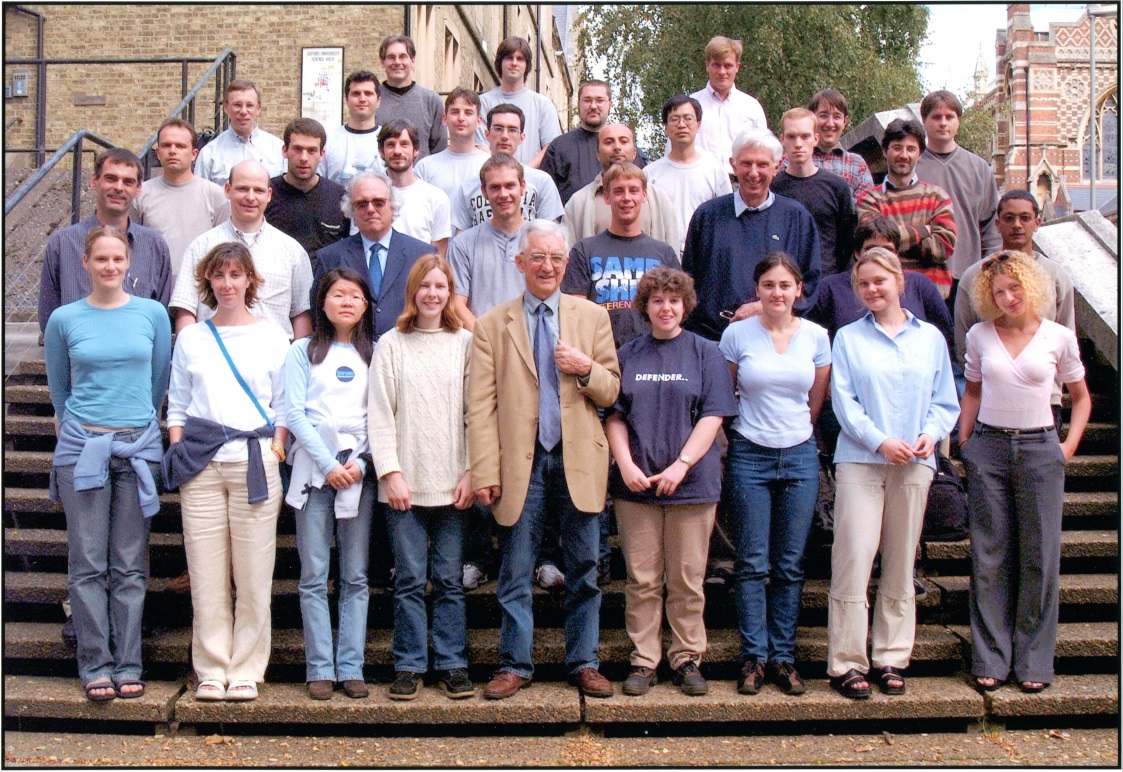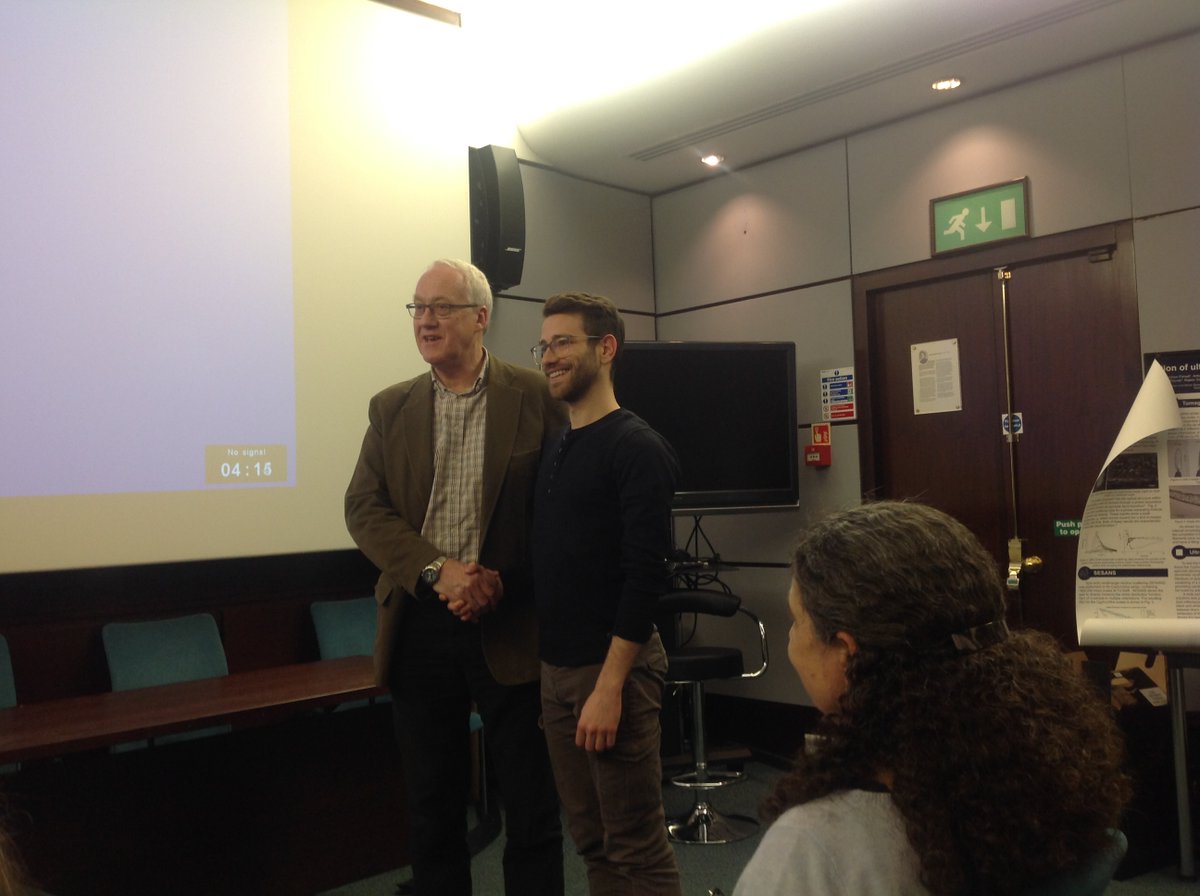On the 9th February 2018, the Institute of Physics (IOP) Neutron Scattering Group gathered for a special meeting at the prestigious IOP headquarters in London. The theme of this one-day event was the application of neutron science to tackle global challenges - more specifically those related to health and healthcare. The meeting honoured the memory of the late Professor Terry Willis, who was widely known for founding the Oxford and Harwell Schools on Neutron Scattering.
Dr Ian Tucker, the Chair of the Committee, made a formal introduction to the meeting and gave a poignant tribute to the late Professor Terry Willis, who recently passed away.

|
The Oxford School on Neutron Scattering back in 2001, Professor Terry Willis, the founder of the school, is in the centre of the front row (brown suit jacket)
|
Professor Terry Willis was well-known amongst the neutron scattering community for the valuable contributions he made to science and the community during a career that spun over six decades. Terry obtained an honours degree in physics from the University of Cambridge in 1948 and a PhD from the University of London in 1951 before joining the Research Laboratories, The General Electric Company in Middlesex. Here, he studied X-ray diffraction on different transition-metal compounds, becoming a specialist on phase transitions as a function of temperature. His first paper back in 1952 was on haematite (α–Fe2O3) which was followed up with a further paper in 1954 based on hexagonal Mn compounds. In the same year, having heard about Harwell from a colleague, George Bacon, Terry successfully interviewed for a job and arrived at the Campus in early 1954. For the next few decades he pioneered the field of neutron science, releasing numerous papers and publishing books such as “Single Crystal Diffractometry" (1966) and “Thermal vibrations in crystallography" (1975). In the 1960s he had his diffractometer working and was very keen on encouraging visitors to come to Harwell. Therefore, when approached by Mick Lomer in 1965 who suggested the prospect of setting up a “School for Neutron Scattering" it was an offer he couldn't refuse. From humble beginnings in 1966, the school has gone from success to success with the latest school, the 16th in its line, taking place in September 2017.
Following the introduction, the audience was treated to a selection of short 30-minute talks on the theme of Neutron Science for Health and Healthcare by members of the Neutron Scattering Group.
Dr David Barlow, from Kings College London presented a talk on “drugs, bugs and neutrons", covering small-angle neutron scattering (SANS) and neutron reflectivity techniques to non-invasively investigate antibiotic resistance in fungal systems. Sans-2d data modelling from the ISIS Neutron and Muon Source indicated that there was a rapid change in the model fungal membrane upon addition of the target drug Amphotec (a 1:1 mixture of amphotericin – a widely used drug for treating fungal infections and cholesterol sulphate). Following comparison between TT-A2 and SANS data, his team were able to infer that Amphotec inserted into the fungal membrane, causing monolayer rearrangement. As structural rearrangement in the fungal system proved to be quicker than in mammalian monolayers, their research provides hope for the possibility of generating an alternative method of combatting antibiotic resistance which makes use of pre-made drugs that are not harmful to human tissue. In a world where we currently have only 3 classes of anti-fungal drugs and resistance is growing at an alarming rate, these results are very promising.

|
A slide from a presentation by Dr Marité Cardenas from Malmo University on “Lipoprotein structure and interactions with model membranes."
|
Coming from a slightly different angle - reflecting the diversity of applications of neutron science- Dr Natasha Rhys from the University of Oxford presented a talk on investigations into the “atomic structure of pharmaceuticals in solution." The postdoctoral researcher from the McLain group at the University of Oxford described how she used the SANDALS instrument at the ISIS Neutron and Muon Source to investigate the role of aromatic rings in affecting the ability of pharmaceuticals to cross the blood-brain-barrier (BBB). By doing so, her team are aiming to paint a bigger picture of the mechanics behind drug transport across the BBB to aid future pharmaceutical design.
Following a short lunch break, the afternoon began with a Neutron Scattering Group AGM where updates to the committee itself were announced alongside facility news and upgrades such as those proposed at the ISIS Neutron and Muon Source, the ILL (Institut Laue-Langevin) and ESS (European Spallation Source). At ISIS, this meant upgrades to TS1, the repair of TS2, NSMUM (UK Neutron and Muon Science and User Meeting) in April and looking forward to the future and next generation capabilities of the department.

|
Nico Paracini from the University of Newcastle being awarded the 2017 Penfold-Thomas Student Poster on Neutron Scattering Prize.
|
This day concluded with the presentation of the 2017 Penfold-Thomas Student Poster on Neutron Scattering Prize. This prestigious award is given annually to an undergraduate or postgraduate degree-level student with a neutron scattering link. This year the honour fell upon Nico Paracini from the University of Newcastle. During his talk, Nico spoke of the research he is currently undertaking into antibiotic interactions with in vitro models of the bacterial outer membrane. Congratulations to Nico! We look forward to hearing more about the exciting research completed by Nico and the rest of the Neutron Scattering Group in the future.
The next Neutron Scattering Group meeting will take place in December 2018, featuring a celebration of Terry Willis’ life and contribution along with some contributions from the recent Willis prize winners.
